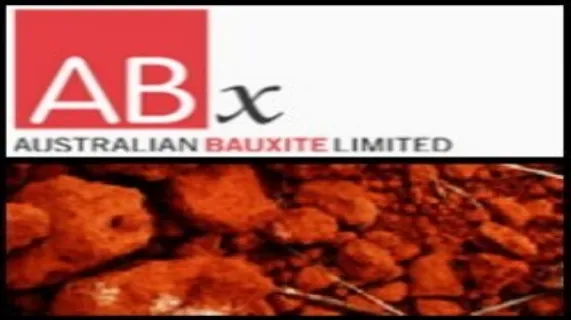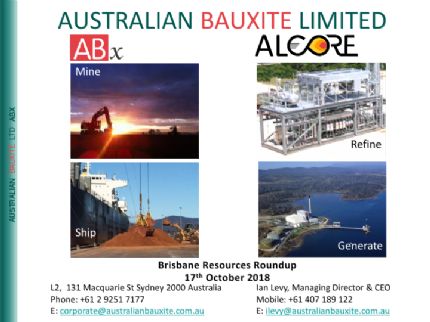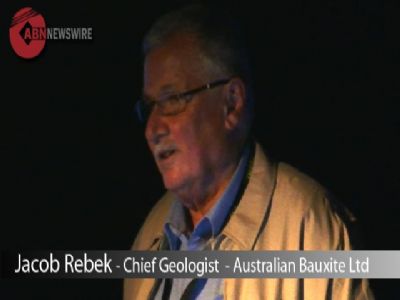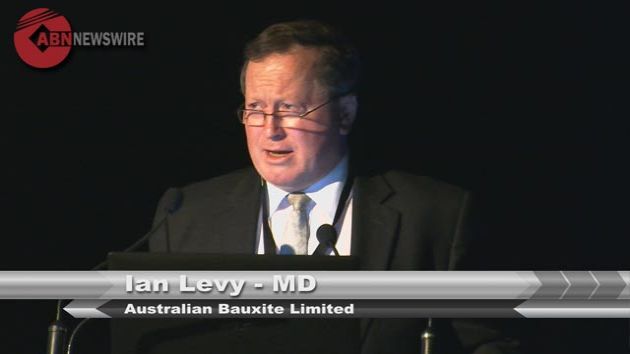
Australian Bauxite Limited (ASX:ABZ) Announce 28 Metre Thick High Grade Bauxite Discovered at Taralga, NSW
Sydney, Jan 30, 2012 AEST (ABN Newswire) - Emerging bauxite exploration and development company, Australian Bauxite Limited ( ASX:ABZ) has received laboratory results from its December 2011 drilling campaign at Taralga near Goulburn, southern NSW (see Figure 1 - refer to ABx announcement link at bottom of release). Results from hole TG626 at Mt Rae (see Figures 2 & 3 for locations) and several nearby holes confirmed the discovery of the company's thickest high-grade bauxite intersection - possibly one of the thickest bauxite intersections in Australia. Most Australian bauxite deposits are less than 4 metres thick and some are less than 2 metres thick whereas hole TG626 intersected 28 metres.
ASX:ABZ) has received laboratory results from its December 2011 drilling campaign at Taralga near Goulburn, southern NSW (see Figure 1 - refer to ABx announcement link at bottom of release). Results from hole TG626 at Mt Rae (see Figures 2 & 3 for locations) and several nearby holes confirmed the discovery of the company's thickest high-grade bauxite intersection - possibly one of the thickest bauxite intersections in Australia. Most Australian bauxite deposits are less than 4 metres thick and some are less than 2 metres thick whereas hole TG626 intersected 28 metres.
Australian Bauxite CEO Ian Levy said; "ABx and Marubeni Corporation ( TSE:8002) are currently conducting a A$1.5 million pre feasibility study of the Goulburn Bauxite Project, and Taralga is one of the bauxite resource study areas that continues to surprise, especially around Mt Rae, west of Taralga."
TSE:8002) are currently conducting a A$1.5 million pre feasibility study of the Goulburn Bauxite Project, and Taralga is one of the bauxite resource study areas that continues to surprise, especially around Mt Rae, west of Taralga."
The district's deposits contain thick zones of premium grade bauxite, with good potential for more discoveries. The recent discovery hole, TG626 remains open at depth and laterally.
All deposits are gibbsite-rich (trihydrate) bauxite with very low levels of reactive silica clays and free of boehmite (monohydrate). All horizons can produce Direct Shipping or "DSO" bauxite (see Definitions).
Resource Estimation Update
Areas of thick, good quality bauxite continue to be discovered across the Taralga - Mt Rae Areas. It is intended to upgrade the resource estimate for Taralga before the end of the current Pre Feasibility Study ("PFS"), which is scheduled to conclude at the end of March. Como Engineers of Perth have been appointed to coordinate cost estimations and prepare the PFS report.
Current bauxite resources at Taralga total 25 million tonnes (see Resource Statement page 4). Metallurgical Results Encouraging: Main Production is DSO Bauxite Metallurgical tests on large samples have been done as part of the Pre Feasibility Study, with METS Engineers of Perth coordinating and summarising the testwork (report in progress).
The Goulburn district bauxite deposits typically have an upper half that contains nodules or "pisoliths" of a black, glassy material which is an emery, comprising mainly fused alumina and trace iron oxides (see Figure 4). Well-known bauxite mineralogist, Professor Eggleton of the Australian National University coined the term "PDM" for these black pisoliths which he found in bauxites from Weipa, Northern QLD. PDM stands for "poorly diffracting material" when subjected to X-ray diffraction.
Metallurgical tests on the PDM-bearing bauxite ("PDM-DSO Bx") from the Taralga area have been able to recover the PDM by gravity methods and the remaining bauxite is good-quality DSO bauxite, similar to the DSO bauxite that typically occurs in the lower half of the deposits (see Figure 4). This means that overall, DSO will represent approximately 75% to 85% of total tonnes produced from the Goulburn Bauxite Project. The recovered PDM emery material can be sold at good prices for industrial uses.
Because this PDM-bauxite layer typically has less than 15% Loss on Ignition "LOI" (see Appendix details), it was previously referred to as "Dehydrated" bauxite. It is now called PDM-DSO Bx bauxite.
Complete results are listed in the Appendix and are summarised in Table 1.
To view the complete Australian Bauxite announcement, including Tables & Figures, please refer to the following link below:
http://media.abnnewswire.net/media/en/docs/ASX-ABZ-664902.pdf
About ABx Group Limited
 ABx Group Limited (ABx) (ASX:ABX) is a uniquely positioned Australian company delivering materials for a cleaner future.
ABx Group Limited (ABx) (ASX:ABX) is a uniquely positioned Australian company delivering materials for a cleaner future.
The three priority projects are:
- Heavy rare earths: Supplying light and heavy rare earths from Tasmania into Western supply chains
o Processing Options Analysis conducted in partnership with external experts
- Clean fluorine chemical production: Producing industrial chemicals from aluminium smelter by-product (ALCORE)
o Continuous pilot plant under construction in Bell Bay, Tasmania
- Near-term bauxite production: Mining bauxite resources for the aluminium, cement and fertiliser industries
o Agreements executed with Good Importing International for bauxite projects in Queensland and New South Wales, and $2.7 million initial payment has been received
o Approvals well advanced for DL130 bauxite project in northern Tasmania
ABx endorses best practices on agricultural land and strives to leave land and environment better than we find it. We only operate where welcomed.
| ||
|














